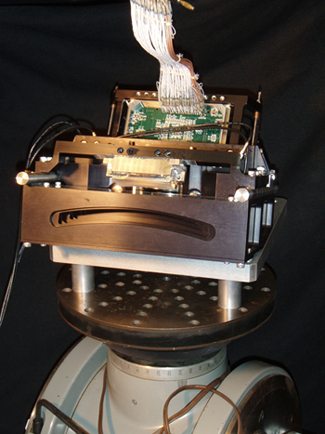
A team of Jet Propulsion Laboratory researchers is collaborating with the Polarization Laboratory at the University of Arizona’s College of Optical Sciences in Tucson to develop a candidate approach for a science instrument to fly aboard a next-generation mission that would survey the impacts of aerosols and clouds on global climate change.
The Multiangle SpectroPolarimetric Imager, or MSPI, is a candidate for the multi-directional, multi-wavelength, high-accuracy polarization imager identified by the National Research Council's Earth Sciences Decadal Survey as one component of the notional Aerosol-Cloud-Ecosystem, or ACE, mission. NASA would fly the ACE spacecraft late in the next decade to characterize the role of aerosols in climate forcing, especially their impact on precipitation and cloud formation. Forcing is the process by which natural mechanisms or human activities alter the global energy balance and “force” the climate to change. The unresolved effects of aerosols on clouds are among the greatest uncertainties in predicting global climate change.
MSPI is conceptually similar to JPL’s Multiangle Imaging SpectroRadiometer, or MISR, carried on NASA’s Terra spacecraft, but with some important additions. The new camera design extends the spectral range to the ultraviolet and shortwave infrared, increases the image swath to achieve more rapid global coverage, and adds high-accuracy polarimetry in selected spectral bands. Like MISR, a suite of MSPI cameras would view Earth at a variety of angles, with an intrinsic pixel size of a few hundred meters, which for certain channels would be averaged up to about 1 kilometer.
JPL atmospheric scientist David J. Diner leads the MSPI development team. "With the MSPI technique, we found innovative methods to overcome some of the usual factors that limit the accuracy of polarization measurements," he said. "We do this with an imager, at moderately high spatial resolution, and have set a challenging goal of half a percent uncertainty in the measured degree of polarization."
The group has completed an initial three-year technology demonstration as proof-of-concept for MSPI under NASA's Instrument Incubator Program, with additional funding from JPL.
Accuracy is the thing
Polarization measurements tend to be more sensitive to certain properties of aerosol particles, such as refractive index, than intensity measurements are. Refractive index is useful because it is a crude proxy for composition. Certain optical characteristics of aerosol particles change with composition; for example, water has a refractive index of 1.33, while a pollution particle has a refractive index of about 1.5. This difference is difficult to distinguish in intensity measurements, but it is much more obvious with highly accurate polarization measurements.
A variety of factors can affect polarization measurement accuracy for an imager, especially differences in optical transmittance or detector sensitivity among the measurements that are combined to observe polarization.*
Diner explains that degree of polarization is the ratio of polarized intensity to total intensity. The MSPI instrument approach provides the necessary parameters as ratios of quantities derived using a single detector, so the optical transmittance or detector sensitivity could vary quite a bit and the ratio will remain the same.
A novel solution
In surveying the relevant literature, Diner and colleagues discovered that a Swiss group had made very precise measurements of the sun’s polarization using a device called a photoelastic modulator. The device is basically a piece of glass with a piezoelectric transducer attached to it that oscillates at a frequency in the tens of kilohertz range. That oscillation sets up a wave in the glass – essentially a high-frequency sound wave. The compression action of the wave induces a phenomenon called stress birefringence into the glass, which causes the polarization state of the light to vary rapidly in a predictable way. When a polarizer is placed between the glass and a detector, the detector will receive an oscillating signal whose amplitude depends on the amount of polarization of the incoming light, and whose average value is related to the total intensity.
With no moving parts, the photoelastic modulator seemed like an excellent technology path, but there was a catch: the MSPI developers, in seeking to employ line array detectors that extend into short-wavelength infrared, needed a modulation time much slower than tens of kilohertz. "We take one line of image in about 40 milliseconds, which is a repeat time, or frame rate, of 25 times per second (25 Hertz). So we needed a modulation rate of tens of Hertz," said Diner.
The novel technique he and his team arrived at was to use two photoelastic modulators, one in front of the other, that oscillate at slightly different frequencies (differing by 25 Hertz). This system creates a beat pattern – a high-frequency oscillation with a much slower embedded signal. The high-frequency oscillation is then averaged out. Embedded in the remaining modulation pattern are the components needed to measure degree of polarization.
Thus, measuring polarization is no longer a matter of combining data from two different detectors and trying to calibrate one against the other. "The technique transforms the challenge from detector-to-detector radiometric calibration into knowing how our photoelastic modulators are operating," Diner said. "And that hopefully shifts the problem to a more manageable and controllable regime."
The first prototype MSPI camera is a field-deployable system operating at the red wavelength of 660 nanometers. Diner and colleagues are currently preparing a second prototype that will monitor eight spectral bands from the ultraviolet to near-infrared (355 to 935 nanometers); the system, to be known as AirMSPI, is aimed at future deployment aboard NASA’s ER-2 aircraft.
Reference
Diner, D.J., A. Davis, B. Hancock, G. Gutt, R.A. Chipman, and B. Cairns. (2007) "Dual photoelastic modulator-based polarimetric imaging concept for aerosol remote sensing." Applied Optics 46, 8428-8445.
* Specifically, by measuring the linear Stokes vector components.
Links
- NASA’s Terra satellite MISR instrument webpage: http://tr.im/lW0N
- NASA’s ER2 High-Altitude Airborne Science Aircraft: http://tr.im/m7CJ